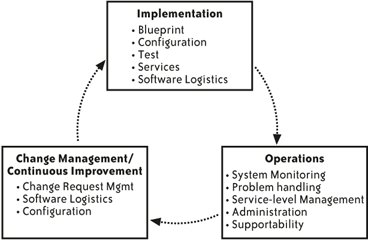Section 18.1. Which operations and management problems will ESA actually solve?
18.1. Which operations and management problems will ESA actually solve?Two operations and management problems that ESA will solve immediately come to mind. The first is strategic and the second is near and dear to CFOs' hearts: continuous availability of processes during software maintenance and lower TCO. Although we will discuss continuous availability and lower TCO in detail later in this chapter, let's consider both quickly them. Continuous availability is the number one operational concern of SAP's customers: how can they upgrade or replace components without having an impact on running business processes? ESA offers a potential solution by decoupling business process and business logicstrategic differentiators that must always be availablefrom core functionality. The decoupling of business and process logic at the heart of ESA will enable business analysts to upgrade processes effectively using modeling tools without affecting the services below and the applications beneath the services. Conversely, it will become simultaneously possible to upgrade or even retire those underlying systemsfirst with new versions and later with services and other components which perform the same taskswhile never disturbing the business processes above, provided that a temporary rerouting of functionality has been planned for. That planning is the key. While the number of moving parts may increase by several orders of magnitude, a standards-based management interface for each service will make it possible to monitor and orchestrate the nonfunctional, operational aspect of thousands of services from a central control centerthe next-generation SAP NetWeaver Lifecycle Management discussed later in this chapterwith minimal effort. These developments are the first steps toward a new requirements-based management model in which the granular details of installations and upgrades are implemented automatically across the entire landscape based on a few high-level instructions, drastically reducing the number of tools and teams of testers necessary and thus lowering TCO. (We'll dub these new approaches and tools "ESA Lifecycle Management" to differentiate from the current situation.) These are the goals, at least. As you'll discover in this chapter, much conceptualizing still needs to be done, new tools need to be created, and new skills must be acquired to make this vision a reality. Figure 18-1 illustrates these phases. Figure 18-1. Phases of life cycle management |
EAN: 2147483647
Pages: 265